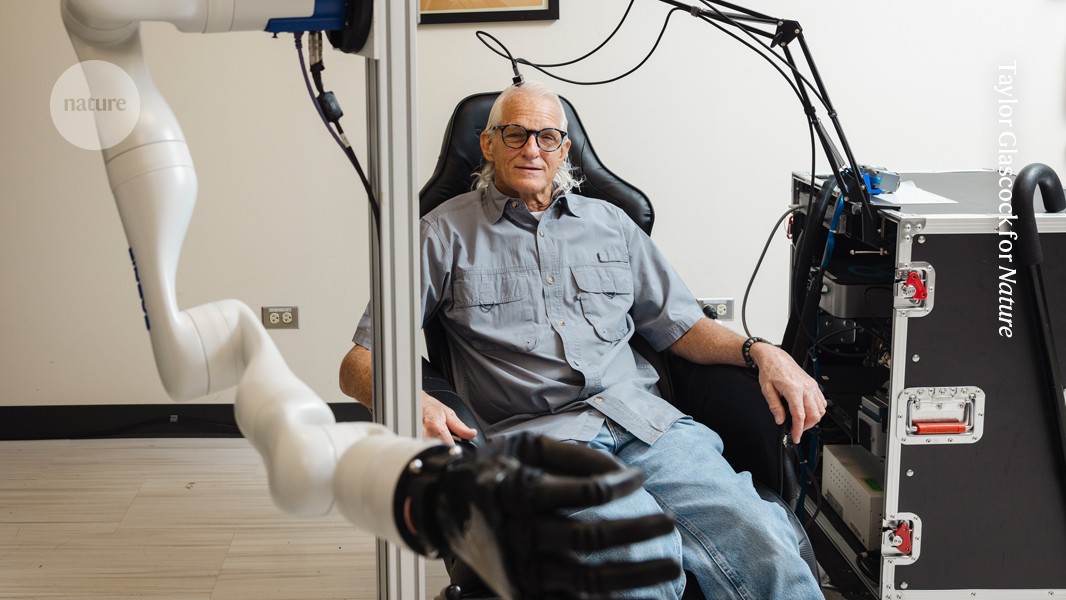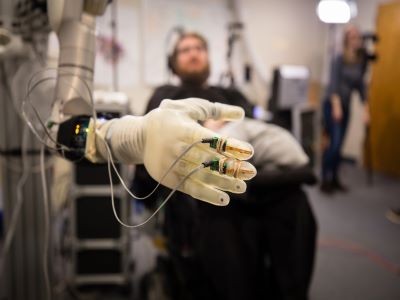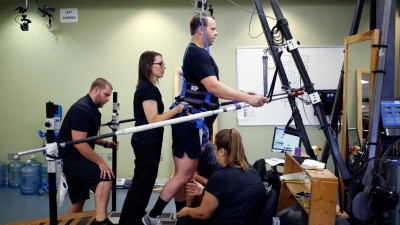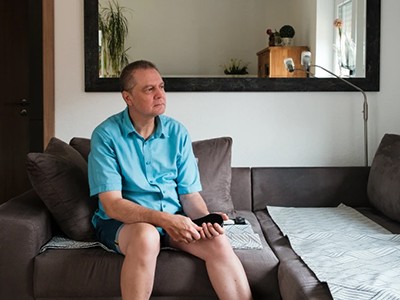Scott Imbrie still remembers the first time that physicians switched on the electrodes sitting on the surface of his brain. He felt a tingling, poking sensation in his hand, like “reaching into an evergreen bush”, he says. “It was like I was decorating a Christmas tree.”
Back in 1985, a car crash shattered three of Imbrie’s vertebrae and severed 70% of his spinal cord, leaving him with very limited sensation or mobility in parts of his body. Now, thanks to an implanted brain–computer interface (BCI), Imbrie can operate a robotic arm, and receive sensory information related to what that arm is doing. Imbrie spends four days a week, three hours at a time, testing, refining and tuning the device with a team of researchers at the University of Chicago in Illinois.
Scientists have been trying to restore mobility for people with missing or paralysed limbs for decades. The aim, historically, was to give people the ability to control prosthetics with commands from the nervous system. But this motor-first approach produced bionic limbs that were much less helpful than hoped: devices were cumbersome and provided only rudimentary control of a hand or leg. What’s more, they just didn’t feel like they were part of the body and required too much concentration to use.
The brain-reading devices helping paralysed people to move, talk and touch
Scientists gradually began to realize that restoring full mobility meant restoring the ability to sense touch and temperature, says Robert Gaunt, a bioengineer at the University of Pittsburgh in Pennsylvania. Gaunt says that this realization has led to a revolution in the field.
A landmark study1 came in 2016, when a team led by Gaunt restored tactile sensations in a person with upper-limb paralysis using a computer chip implanted in a region of the brain that controls the hand. Gaunt then teamed up with his Pittsburgh colleague, bioengineer Jennifer Collinger, to integrate a robotic arm with the BCI, allowing the individual to feel and manipulate objects2. “It meant they could perform motor tasks much faster,” says Collinger. Around the same time, studies in people with limbs that have been amputated showed how restoring tactile inputs into peripheral nerves also drastically improved control of prosthetic hands3.
But researchers haven’t fully cracked the code on how to interpret or create natural sensations that truly benefit people’s lives. Somatosensation — the collection of senses that interpret touch, temperature, pain and body position — is dauntingly complex. Imagine trying to encode information that could discern a soft kiss from a painful pinch, or the needles of a pine tree from the bristles of a paintbrush. To create safe and stable interfaces with the brain and body, researchers need to make major advances in engineering as well as in understanding the sensorimotor system, says Rochelle Ackerley, a neuroscientist at Aix-Marseille University in France. And as developers look to increase the size of implanted-device trials, stakeholders have yet to solve ethical issues around the risks of BCIs and high-tech prosthetic devices.
A battery to the tongue
Prosthetics developers are beginning to create sensations that feel real and natural, but it’s a work in progress. When Imbrie thinks back to the first tests of his BCI, he says that the sensations were a bit “like holding a battery to the tongue; not painful, but more like electricity”.
One of the first challenges is the plethora of information that needs to be encoded. “When we touch an object, different sensory neurons in our skin code its shape, pressure and texture,” says Giacomo Valle, a neuroengineer at Chalmers University of Technology in Gothenburg, Sweden. Valle has been attempting to mimic these neural codes, then deliver them to the brain, either through the body’s sensory nerves or directly to the cortex.
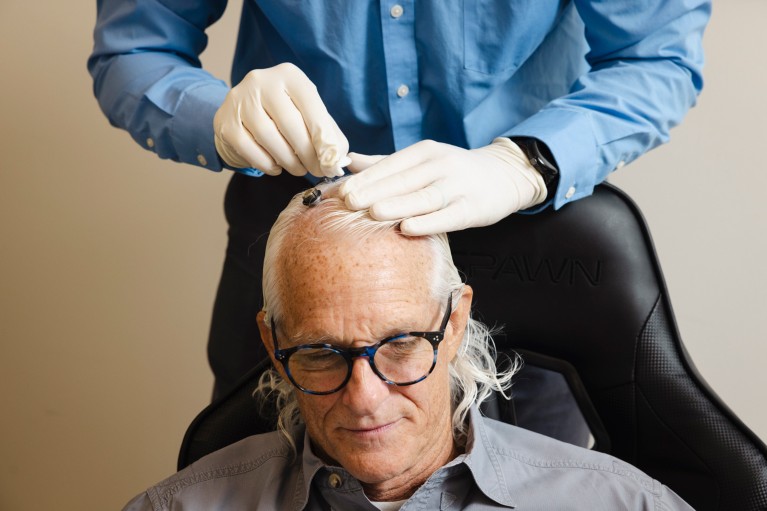
Pedestals on Scott Imbrie’s scalp lead to electrode arrays in motor and sensory areas of his brain.Credit: Taylor Glascock for Nature
Valle worked with Imbrie during his postdoc in the laboratory of Sliman Bensmaia who was at the University of Chicago, drawing knowledge from decades of animal research about how to create different types of tactile sensation. He learnt that tweaking the parameters of electrical impulses creates very specific sensations of textures, pressures and stroking directions. When constructed together, these impulses form sensations of objects. Valle and his colleagues’ latest study4 shows just how far this approach has come. Through the electrodes in Imbrie’s brain, physicians were able to create the sensation of touching the edge of a shape or feeling the motion of an object dragged across Imbrie’s fingertips. Imbrie remembers the vivid feeling when Valle drew certain letters on the interface for Imbrie to interpret. “I said, ‘Oh my, Giacomo, you just drew an O on my fingertip’, and I could see the grin coming from his face,” says Imbrie.
The principle is exactly the same in people who have had an amputation, but technically more straightforward because tactile signals can be routed into residual nerves in the part of a person’s limb that remains. This technique is allowing individuals to better manipulate and detect objects with bionic hands, or have better balance and gait with bionic legs.
Vision without colour
Going beyond tactile inputs, researchers including neuroengineer Solaiman Shokur at the Swiss Federal Institute of Technology in Lausanne (EPFL) are beginning to bring back other aspects of somatosensation, such as discerning temperature. Shokur thinks that restoring multisensory inputs will return all the warmth and feeling that somatosensation gives us. “Touch without temperature is like vision without colour,” he says.
Shokur has created warm and cool sensations in the ‘phantom’ hands of people with an upper-limb amputation by stimulating nerves in their remaining limb with a thermal device5. These stimulations triggered very real and natural thermal sensations that people interpreted as coming from their missing hand.
By chance, one of the participants in Shokur’s trial had also participated in Valle’s trials recreating touch sensations. “Her first reaction with thermal sensation was, ‘Wow! This was what was missing the whole time’,” says Shokur.
Embodied prosthetics
Hugh Herr, an engineer at Massachusetts Institute of Technology in Cambridge is not convinced that restoring every facet of somatosensation, such as cooling or warmth, is the most important goal for helping people. Herr says that the priority should be restoring those sensory inputs that most improve mobility and function. Above all, he says, it’s important to have prosthetic limbs that feel to users like they’re part of their body, and not just bionic, artificial attachments — a sensation known as embodiment. “When amputees experience natural sensations from their prosthesis as if it was their own limb, and when people can think and move their prosthesis with little error, it gives them a sense of ownership and agency,” says Herr.
He is acutely aware of how painful poorly designed prosthetics can be: both his legs were amputated after a rock-climbing accident, and he has spent 30 years researching ways to build functional prostheses.
Herr says that the current revolution in this field stems from successes in integrating sensory components into prostheses. Designers are merging multiple tissues of the body — muscle, tendon, bone and nerves — with synthetic technologies to drive human–machine integration to the next level. Herr’s research team is focusing on surgical techniques and implants that improve on the electrodes used in current bionic-limb systems, which either penetrate the peripheral nerves or wrap around them. “We’re reimagining how limbs should be amputated and bionic limbs constructed,” he says.
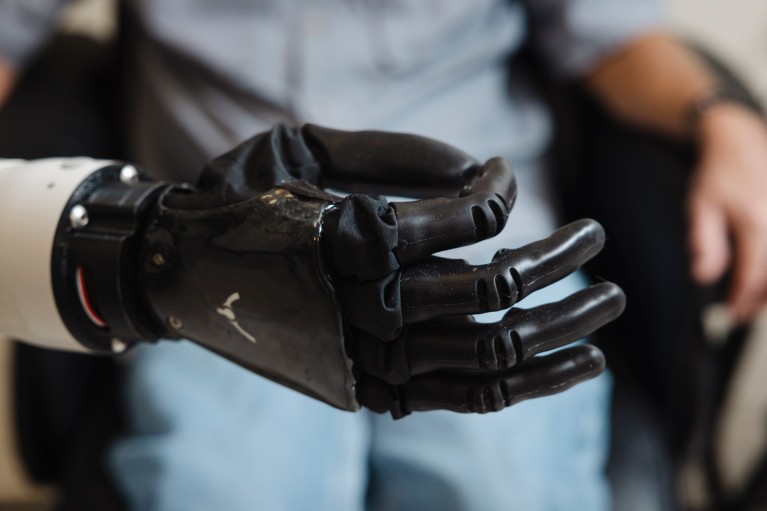
Imbrie’s implants allow him to manipulate objects but also provide tactile feedback.Credit: Taylor Glascock for Nature
Herr’s group, along with collaborators such as Matthew Carty at Brigham and Women’s Hospital in Boston, Massachusetts, have developed a method of restoring sensory inputs by regrowing nerves in the residual part of an amputated leg, sometimes referred to as the stump. The idea is to make the stump sense when a prosthetic limb hits the ground while walking, but have the sensation felt in the phantom foot rather than in the stump. The approach involved taking parts of the person’s heel skin and surgically attaching them to intact sensory nerves in the stump. The skin graft is connected to a muscle–computer interface, which contracts the muscle to mechanically activate the sensory nerve. “When that muscle fires and applies a strain on the skin, the person feels heel strike,” says Herr. Initially developed in rats, the method is now being tested in a clinical trial. It’s early days, but unpublished data suggest that people can feel toe movements and heel pressures. Herr is now testing how this affects bionic-limb embodiment and motor capabilities.
In a publication in July6, Herr and his colleagues demonstrated a similar approach that aims to reproduce the sense of limb positioning, known as proprioception. It had “remarkable” results on bionic legs, restoring almost all mobility, he says. “If we restored just 18% of total proprioception into the nerve, patients could run up and down steps without a handrail,” says Herr. However, the BCI didn’t restore naturalistic sensations — individuals didn’t consciously feel the proprioceptive inputs.
How a revolutionary technique got people with spinal-cord injuries back on their feet
Gaunt says that Herr’s system is an impressive demonstration of how restoring proprioception can improve overall function of prosthetic limbs. The benefit, he says, is that the improvement comes through surgery combined with non-invasive neural prosthetics, but he questions how scalable the approach is.
Studies are also showing a somewhat unexpected outcome of creating more embodied prosthetic limbs — alleviating phantom-limb pain3. This pain, which feels like it comes from the part of the limb that is missing, is a major issue for many people with amputated limbs. “Peripheral-nerve stimulation can decrease phantom-limb pain by recovering lost or erroneous signals at the site,” Ackerley says. It’s becoming clearer, she adds, that bionic devices that stimulate peripheral nerves can also improve affective and social touch, increase comfort and reconnection with a missing limb and prevent ‘telescoping’, which is the feeling of a phantom limb ‘shrinking’ into the stump. “Embodiment and pain are major issues that bionic devices can tackle, providing ways to make prosthetic limbs useful on a more psychological level,” Ackerley says.
E-skins
Integrating sensory inputs into a prosthetic limb, either through BCIs or by connecting with peripheral nerves, goes a long way towards replacing a lost arm or leg, but creating a realistic limb, complete with simulated skin, is what many consider the ideal. Zhenan Bao, an engineer at Stanford University in California, talks of the mark that science-fiction films, such as those in the Star Wars franchise, have left on the field. Luke Skywalker’s bionic hand in Return of the Jedi (1983) still serves as the “moonshot idea” of a bionic limb gloved in synthetic skin, she says. Electronic skins, or e-skins, pull together advances in neuroscience and engineering and could open up the capabilities of prostheses. Although first developed in the 1970s, the field entered a new phase with e-skins when Bao showcased7 a high-tech example in 2023.
“We’re starting to create artificial materials that look and feel like skin. They’re capable not only of sensing information from the environment but can also generate signals to directly communicate with the nervous system to create natural sensations,” says Bao.
The brain-reading devices helping paralysed people to move, talk and touch
A handful of labs are working on improving the capabilities of various integral components of e-skin, including environmental sensors, microcircuits that convert the sensory signals into digital outputs and electrical interfaces to connect the sensors with peripheral nerves. Nitish Thakor, a neuroengineer at Johns Hopkins University in Baltimore, Maryland, who works on e-skins, says that progress has only been possible because of breakthroughs in two major domains. First, in nanomaterials and electronics, through “making flexible and organic transistors that act like a touch receptor in the skin”, and can self-heal when damaged8. Second, in neuroscience, by converting sensory information into digital data “as spikes that can be used to stimulate the nervous system”, he says.
Bao is most excited about the idea of using e-skins to “go beyond human capabilities”. One of the studies she was involved in showed an e-skin that is so tightly packed with mechanical sensors that it can read entire words in Braille, instead of one letter at a time9. “You can also imagine other sensors allowing us to know things like the chemical contents of objects,” says Bao.
Thakor highlights one glaring issue with e-skins, however: none has yet been trialled in humans or integrated into prosthetics. Bao says that she aims to test commercially produced e-skins in people fitted with prostheses in the next two years.
Challenges ahead
Although developments in BCIs, neuroprostheses and e-skins have been remarkable, the field is a long way from using them to improve people’s daily lives. Individuals who benefit from these technologies only do so as part of clinical trials, often with intensive, expensive in-lab testing schedules. It’s not yet clear how or when they could take their devices home without the need of scientists “twiddling knobs”, says Gaunt.
A major problem that researchers are trying to solve is neural interfacing. Currently, scientists can create precisely localized sensations only by stimulating the somatosensory cortex, not through peripheral nerves. But they are testing a number of techniques, such as optogenetics — a way to control the activity of specific sets of neurons with light, and high-resolution electrodes to selectively stimulate individual nerve fibres. Bao, for one, is working on these approaches, but says that they’re still early in development.
Abandoned: the human cost of neurotechnology failure
Outside the lab, the most pressing issues for individuals relates to ethical and access concerns, says Jennifer French, executive director of Neurotech Network, a patient advocacy and support organization in St. Petersburg, Florida. “We’re at a pivotal point of moving towards clinical trials, testing these devices in larger groups of patients, but there are many questions around understanding the spectrum of risks versus benefits,” she says. French listed many complex ethical questions, such as what are the clinical pathways for being fitted with devices? What should the clinical trial endpoints be? And how will health services make decisions about whether to pay for such devices?
Another concern is what happens when devices fail, or the makers of a device go bankrupt and the person is left with unsupported or non-working implants. “This is a real risk, and we have seen it demonstrated,” says Gaunt.
French is working with regulatory partners, funders, patient-advocacy groups and other stakeholders to create clinical and research frameworks. “We need guidance,” she says, both for device developers and clinicians. “But we don’t have solutions yet.”
Imbrie is positive about the changes he has experienced since he first started testing the bionic arm that interfaces with his brain. Four years worth of tests have even helped him to relearn some of the natural sensations in parts of his body. “When I started, my right side — it always felt dull or numb compared to the left side. Now when the doctor does the same test, both sides feel identical,” he says. And these sensations are feeling increasingly real. “I can feel my brain getting reprogrammed to feel different types of stimuli. It’s like being a child learning to touch, but I have the language and imagination to describe how I’m perceiving things,” he says.
Herr mirrors Imbrie’s optimism. With innovative interfaces between machine and flesh emerging, Herr is hopeful that restored function will soon become more than just a laboratory trick.


